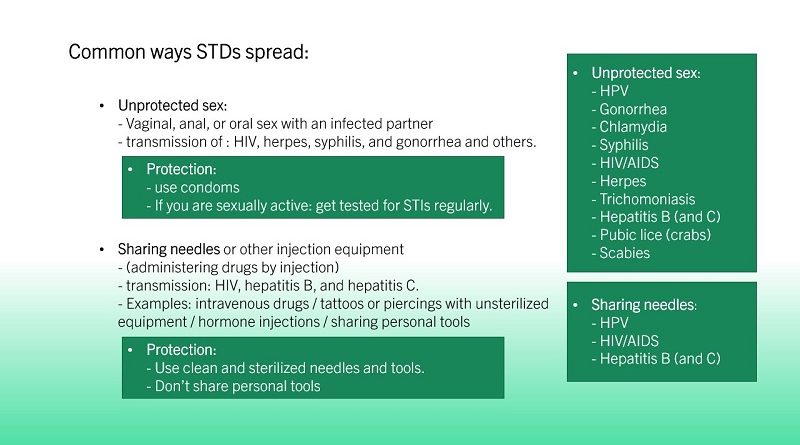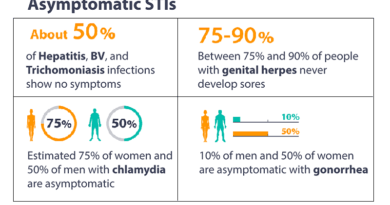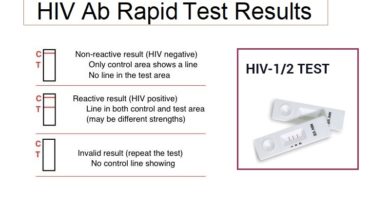2- Sexually transmitted Infections (STIs). Transmission
Before reading this article, (part- 2: Sexually transmitted Infections Transmission), you may want to read parts 1. Click her for part-1.
IV. Transmission of Sexually transmitted Infections (STIs)
Sexually transmitted Infections Transmission is primarily through sexual contact, (vaginal, anal, and oral). Some STDs can also be spread through non-sexual contact, through contaminated sharp tools, such as sharing needles or personal care tools with an infected person. Also, they can spread from mother to baby during childbirth or breastfeeding.
Common ways of STIs transmission
- Unprotected sex: Any type of sexual contact with an infected partner can lead to the transmission of sexually transmitted infections (STIs), including through seminal, vaginal, and anal fluids. It is important to consider protection, such as using condoms, during sexual activity to reduce the risk of STI transmission. Also, it is important, if you are sexually active, to get tested for STIs regularly and let your partners know of any potential risks.
- HIV: the virus can be transmitted to the baby during pregnancy, childbirth, or breastfeeding
- Hepatitis B: the virus can be transmitted to the baby during childbirth if the mother is infected
- Hepatitis C: the virus can be transmitted to the baby during pregnancy or childbirth, but the risk is low
- Syphilis: the infection can be transmitted to the baby during pregnancy or childbirth
- Herpes: the virus can be transmitted to the baby during a vaginal delivery if the mother has an active herpes outbreak at the time of delivery.
To reduce the risk of transmission, it is important for all pregnant women to be tested for these infections. Additionally, HIV-positive mothers can take antiretroviral medications during pregnancy and childbirth to reduce the risk of transmission to their babies. Avoiding breastfeeding is also a good way to avoid transmission of the infections.
- Sharing needles or other Sharp tools with infected persons can lead to the transmission of blood-borne infections, such as HIV, hepatitis B, and hepatitis C. This highlights the importance of using sterile and single-use equipment, as well as avoiding sharing needles or other others.
Examples of situations where sharing needles or injection equipment may occur include:- Using intravenous drugs such as heroin, methamphetamine, or opioids
- Getting tattoos or piercings with unsterilized equipment
- Receiving hormone injections
- Sharing personal care items such as razor blades or ear-piercing guns.
- Infected mother to her baby during childbirth or breastfeeding.
Examples of infections that can be transmitted from an infected mother to her baby include:- HIV: the virus can be transmitted to the baby during pregnancy, childbirth, or breastfeeding
- Hepatitis B: the virus can be transmitted to the baby during childbirth if the mother is infected
- Hepatitis C: the virus can be transmitted to the baby during pregnancy or childbirth, but the risk is low
- Syphilis: the infection can be transmitted to the baby during pregnancy or childbirth
- Herpes: the virus can be transmitted to the baby during a vaginal delivery if the mother has an active herpes outbreak at the time of delivery.
- Chlamydia
- Gonorrhea
To reduce the risk of transmission, all pregnant women have to be tested for STI infections. Additionally, HIV-positive mothers have to take antiretroviral medications, (ART), during pregnancy and childbirth. Also, avoiding breastfeeding is a good way to avoid transmission of the infections.
- Direct contact with sores or other lesions can lead to the transmission of STIs through skin-to-skin contact.
Examples of infections that can be transmitted through skin-to-skin contact include:- Herpes: the virus can be transmitted through direct contact with an active herpes sore or blister
- HPV: the virus can be transmitted through direct skin-to-skin contact with an HPV-infected area, such as a wart or cervical lesion
- Syphilis: the infection can be transmitted through direct contact with a syphilis sore, known as a chancre
- Scabies: the mite that causes scabies can be transmitted through direct contact with an infected person’s skin
- Impetigo: a bacterial infection can be transmitted through direct contact with an infected person’s skin.

SUMMARY
STIs are primarily spread through sexual contact, e.g. vaginal, oral, and anal, but some can also be transmitted non-sexually, through contaminated sharp tools. Protect yourself and loved ones by using protection during sexual activity, getting tested regularly, avoiding sharing needles and sharp tools, and through testing and ART during pregnancy. STIs can also be spread through direct contact with sores/lesions, such as herpes, HPV, syphilis, scabies, and impetigo.
SOURCES
- https://www.medicalnewstoday.com/articles/327267
- STIs – (who.int)
- Centers for Disease Control and Prevention (CDC)
- American Sexual Health Association (ASHA)
- National Institute of Allergy and Infectious Diseases (NIAID)
| Mode of Transmission | Examples of STDs | Prevention |
|---|---|---|
| Unprotected sex | HIV, herpes, syphilis, gonorrhea | Use protection (condoms), regular STI testing |
| Sharing needles or other injection equipment | HIV, hepatitis B, hepatitis C | Use clean and sterilized needles and tools |
| Mother to baby | HIV, hepatitis B, hepatitis C, syphilis, herpes | Testing for STIs during pregnancy, antiretroviral medications, avoiding breastfeeding |
| Direct contact | Herpes, HPV, syphilis, scabies, impetigo | Avoiding skin-to-skin contact with sores or discharges |
Discover more from Helal Medical Manila
Subscribe to get the latest posts sent to your email.




